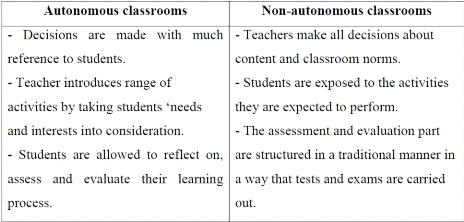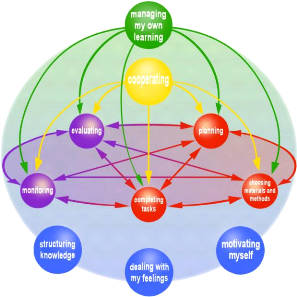-24-
I-Literature review on learner autonomy in
education
In the same regard, Nunan (1996) argues that the teachers'
and learners' roles, in the classroom, have been changed. As Marguerite Fitch
put it at the annual conference of the American Educational Research
Association in New Orleans in April 1994, «The teacher's role changes from
the `Sage on the Stage' to the Guide on the Side.»(Tella, 1996:6). Thus,
he suggests some roles which may help both teachers and learners in creating an
autonomous learning environment through comparing between autonomous and
non-autonomous classrooms in this table:

Table 3 : Comparison between Autonomous and
Non-autonomous Classrooms.
(Nunan, 1996:21)
12-The learner motivation and self-esteem
Language learning is not merely a cognitive task. Learners do
not only reflect on their learning in terms of the language input to which they
are exposed, or the optimal strategies they need in order to achieve the goals
they set. Rather, the success of a learning activity is, to some extent,
contingent upon learners' stance towards the world and the learning activity in
particular, their sense of self, and their desire to learn.
(Thanasoulas,2000)
-25-
I-Literature review on learner autonomy in
education
12-1-Learner motivation
Although the term 'motivation' is frequently used in
educational contexts, there is little agreement among experts as to its exact
meaning. What most scholars seem to agree on, though, is that motivation is
'one of the key factors that influence the rate and success of second or
foreign language (L2) learning. Motivation provides the primary impetus to
initiate learning the L2 and later the driving force to sustain the long and
often tedious learning process' (Dornyei, 1998: 117). According to Gardner and
MacIntyre (1993: 3), motivation is comprised of three components: 'desire to
achieve a goal, effort extended in this direction, and satisfaction with the
task'. (Thanasoulas,2000)
12-2-Learner self-esteem
Closely related to attitudes and motivation is the concept of
self-esteem, that is, the evaluation the learner makes of herself with regard
to the target language or learning in general. '[S]elf-esteem is a personal
judgment of worthiness that is expressed in the attitudes that the individual
holds towards himself'. Conversely, a lack of self-esteem is likely to lead to
negative attitudes towards his capability as a learner, and to 'a deterioration
in cognitive performance', thus confirming his view of himself as incapable of
learning. (Thanasoulas,2000)
13-The autonomy dynamic model
Maria Giovanna Tassinari, director of the Centre for
Independent Language Learning (CILL) at the Freie Universität Berlin and
advisor, reached the autonomy dynamic model that she describes as follows :
-26-
I-Literature review on learner autonomy in
education
«Every autonomous learning process should entail
an evaluation of the learner's competencies for autonomy. The dynamic model of
learner autonomy described in this paper is a tool designed in order to support
the self-assessment and evaluation of learning competencies and to help both
learners and advisors to focus on relevant aspects of the learning process. The
dynamic model accounts for cognitive, metacognitive, action-oriented and
affective components of learner autonomy and provides descriptors of learners'
attitudes, competencies and behaviors. It is dynamic in order to allow learners
to focus on their own needs and goals.» (Tassinari,2012:24)
The dynamic model she makes is shown in the following figure
Fig. 4.

Fig. 4: Autonomy dynamic model
(Tassinari,2012:29).
| 


